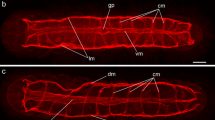Summary
Ultrastructural aspects of the natural degeneration of a group of six motor neurons in the fourth abdominal ganglion of Manduca sexta are described. These motor neurons innervate intersegmental muscles that degenerate and disappear immediately after adult eclosion. The first detectable changes in the cell bodies appear 12 h after eclosion and include disruption of the endoplasmic reticulum and an increase in the size and number of lamellar bodies. At 32 h the nuclear membranes rupture, and the membranous and granular cytoorganelles segregate in different parts of the cell. At that stage the surrounding glial cells participate in the digestion of material from the degenerating neurons. From 72 h onward the remaining neuronal structures become disrupted, and are finally transformed into a single, large lamellar body (residual body) within the glial profile. The degeneration pattern differs significantly from that of embryonic vertebrate neurons.
Similar content being viewed by others
References
Anderson, C.A., Westrum, L.E.: An electron microscopic study of the normal synaptic relationships and early degenerative changes in the rat olfactory tubercle. Z. Zellforsch. 127, 462–482 (1972)
DeDuve, C.: Structure and functions of lysosomes. In: Funktion und morphologische Organisation der Zelle (P. Karlson, ed.). Berlin-Heidelberg-New York: Springer 1963
Edwards, J.S.: The composition of an insect sensory nerve, the cereal nerve of the house cricket Acheta domesticus. Proc. Electron Micr. Soc. Amer. 17, 248–249 (1971)
Finlayson, L.H.: Normal and induced degeneration of abdominal muscles during metamorphosis in the Lepidoptera. Quart. J. micr. Sci. 97, 215–233 (1956)
Lamparter, H.E., Akert, K., Sandri, C.: Wallersche Degeneration im Zentralnervensystem der Ameise. Elektronenmikroskopische Untersuchungen am Prothorakalganglion vom Formica lugubris Zett. Schweiz. Arch. Neurol. Psychiat. 100, 337–354 (1967)
Lockshin, R.A., Beaulaton, J.: Programmed cell death. Life Sci. 15, 1549–1565 (1974)
Lockshin, R.A., Williams, C.M.: Programmed cell death. I. Histology and cytology of the breakdown of the intersegmental muscles in saturniid moths. J. Insect Physiol. 11, 123–133 (1965)
Nüesch, H., Stocker, R.F.: Ultrastructural studies on neuromuscular contacts and the formation of junctions in the flight muscle of Antheraea polyphemus (Lep.). II. Changes after motor nerve section. Cell. Tiss. Res. 164, 331–355 (1975)
O'Connor, Th.M., Wyttenbach, Ch.R.: Cell death in the embryonic chick spinal cord. J. Cell Biol. 60, 448–459 (1974)
Rees, D., Usherwood, P.N.R.: Fine structure of normal and degenerating motor axons and nerve-muscle synapses in the locust, Schistocerca gregaria. Comp. Biochem. Physiol. 43A, 83–101 (1972)
Reynolds, E.S.: The use of lead citrate at high pH as an electron-opaque stain in electron microscopy. J. Cell Biol. 17, 208–212 (1963)
Reynolds, S.E., Taghert, P.H., Truman, J.W.: Eclosion hormone and bursicon titres and the onset of hormonal responsiveness during the last day of adult development in Manduca sexta (L). Submitted for publication (1978)
Richardson, K.C., Jarett, I., Finke, E.H.: Embedding in epoxy resins for ultrathin sectioning in electron microscopy. Stain Technol. 35, 313–323 (1960)
Smith, D.S.: Insect cells. Their structure and function. Edinburgh: Oliver and Boyd 1968
Spencer, P.S., Thomas, P.K.: Ultrastructural studies of the dying-back process. II. The sequestration and removal by Schwann cells and oligodendrocytes of organelles from normal and diseased axons. J. Neurocytol. 3, 763–783 (1974)
Stocker, R.F. : Analysis of a peripheral nerve in the leg-like antenna of Antennapedia, a homeotic mutant in Drosophila (in preparation)
Taylor, H.M., Truman, J.W.: Metamorphosis of the abdominal ganglia of the tobacco hornworm, Manduca sexta. Changes in populations of identified motor neurons. J. comp. Physiol. 90, 367–383 (1974)
Truman, J.W.: The eclosion hormone: Its release by the brain and its action on the central nervous system of silkmoths. Amer. Zool. 10, 511–512 (1970)
Truman, J.W.: Physiology of insect rhythms. I. Circadian organization of the endocrine events underlying the moulting cycle of larval tobacco hornworms. J. exp. Biol. 57, 805–820 (1972)
Truman, J. W.: How moths “turn on” : A study of the action of hormones on the nervous system. Amer. Sci. 61, 700–706 (1973)
Tung, A.S.-C., Pipa, R.L.: Fine structure of transected interganglionic connectives and degenerating axons of wax moth larvae. J. Ultrastr. Res. 36, 694–707 (1971)
Author information
Authors and Affiliations
Rights and permissions
About this article
Cite this article
Stocker, R.F., Edwards, J.S. & Truman, J.W. Fine structure of degenerating abdominal motor neurons after eclosion in the sphingid moth, Manduca sexta . Cell Tissue Res. 191, 317–331 (1978). https://doi.org/10.1007/BF00222427
Accepted:
Issue Date:
DOI: https://doi.org/10.1007/BF00222427




